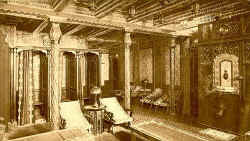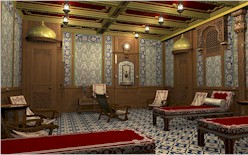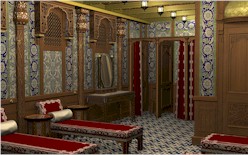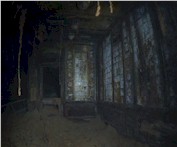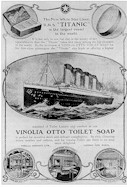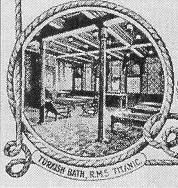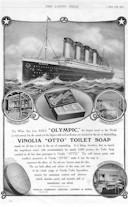There was considerable rivalry between the Cunard and White Star Lines before their merger in 1934. So when Cunard introduced the Lusitania and Mauretania on their transatlantic route, White Star followed almost immediately with their Olympic and Titanic counterparts.
Both were designed to provide the ultimate in luxury travel and both had virtually identical swimming pools with adjacent Turkish baths suites. The midsummer issue of The Shipbuilder1 was a special number devoted to these sister ships which were, at the time, considered to be the peak of British shipbuilding achievement. The description of the Turkish baths in the article applied in all but the smallest detail to both ships, though most of the images which survive are actually of the Olympic.
< Image: Postcard in author's collection
On the other hand, Bruce Beveridge’s plan of F Deck (Middle Deck) is based on the March 1912 version of the First Class Plan of Passenger Accommodation for the Titanic.7
< Plan: Bruce Beveridge
The Swimming Bath was located on the starboard side of F Deck (next to the right hand side of the plan), just forward of the Turkish Bath which conveniently adjoined the main companionway. In addition to the hot, temperate, and cooling-rooms, there were two shampooing rooms, a steam room and a single electric bath.
By all published accounts, the cooling-rooms were the most extraordinary rooms in the two ships, and were decorated in the 'Arabian' style of the seventeenth century. For once, perhaps, publicity material did justice to its subject:
The portholes are concealed by an elaborately carved Cairo curtain, through which the light fitfully reveals something of the grandeur of the mysterious East. The walls from the dado to the cornice are completely tiled in large panels of blue and green, surrounded by a broad band of tiles in a bolder and deeper hue. The ceiling cornice and beams are gilt, with the intervening panels picked out in dull red. From the panels are suspended bronze Arab lamps. A warm coloured teak has been adopted for the dado, doors, and panelling, and forms a perfect setting to the gorgeous effect of the [mosaic floor] tiles and ceiling. The stanchions, also cased in teak, are carved all over with an intricate Moorish pattern, surmounted by a carved cap. Over the doors are small gilt domes, semi-circular in plan, with their soffits carved in low relief geometrical pattern. Low couches are placed around the walls with an inlaid Damascus table between each, upon which coffee and cigarettes or books may be placed. On one side is a handsome marble drinking fountain, set in a frame of tiles. A teak dressing table and mirror, with all its accessories, and a locker for valuables are also provided, while placed around the room are a number of canvas chairs.1
Although there are several photographs of the cooling-room in the Olympic, this is the only one taken of the one in the Titanic. Comparing it with the photo above, it can be seen that while the motif was the same, the layout was different.
< Ken Marschall collection.
The true splendour of the Titanic's decorative scheme and of the furniture and fittings can be seen in two wonderful renderings of the interior by Parks Stephenson.
< Renderings above and tiles below, courtesy Parks Stephenson
![]() The tiled floors of different areas of the two ships often had their own set of colours.
Lavish though the finish of the interiors of the Turkish baths were,
they were designed—unlike many interiors in other Turkish baths—to
withstand the constant damp and heat which is unavoidable in such
an environment. That the fitters were supremely successful in combating
such conditions is clear from the condition of the cooling-room after
its survival on the ocean bed for almost one hundred years. This can be
seen in the wide-angled mosaic assembled by Ken Marschall from
numerous images taken during James Cameron's 2005 Remotely Operated Vehicle (ROV)
underwater exploration.
The tiled floors of different areas of the two ships often had their own set of colours.
Lavish though the finish of the interiors of the Turkish baths were,
they were designed—unlike many interiors in other Turkish baths—to
withstand the constant damp and heat which is unavoidable in such
an environment. That the fitters were supremely successful in combating
such conditions is clear from the condition of the cooling-room after
its survival on the ocean bed for almost one hundred years. This can be
seen in the wide-angled mosaic assembled by Ken Marschall from
numerous images taken during James Cameron's 2005 Remotely Operated Vehicle (ROV)
underwater exploration.
< © James Cameron, 2005; enhancement and mosaic by Ken Marschall.
The facilities provided for First Class passengers were perceived as exemplifying the ultimate in luxury, and suppliers of goods to the Titanic were not slow to advertise the fact, rather as those patronised by the royal family still boast their 'By Appointment' logos.
An advertisement for Vinolia Otto Toilet Soap appeared in the Illustrated London News on 10 April, just days before the fatal disaster.
< Illustrated London News (10 Apr 1912)
The vignette of the Turkish bath is exactly the same as that used in an earlier advert for the soap as used on the Olympic.6
< The Ladies Field
(10 Jun 1911)
Even today the Turkish bath is shown on items such as commemorative plates.
Since the Turkish baths were adjacent to the swimming pool, which was restricted to First Class passengers, it must be assumed that the Turkish baths were similarly restricted. On the Olympic, the baths were reserved for the use of Ladies from 10 am to 1 pm, and for Gentlemen from 2 to 7 pm, at a charge of 4/- (or $1) per visit.2
Because of the tragic history of the Titanic, almost anything to do with the ship is avidly sought by collectors. Although quite a few tickets entitling a passenger to a Turkish (or electric) bath seem to have survived, No.657 (similar to the one above) fetched £900 at Onslow's Auction sale on 11 April 1990.3
Passengers on the Titanic, having paid their dollar, were well looked after by a team of five staff, three men (J B Crosbie, W Ennis, and L Taylor—none of whom was to survive the voyage) and two women (Annie Caton and Mrs Maud Slocombe—both of whom were more fortunate).4
But, in spite of such care and attention, not all passengers enjoyed their Turkish bath on board. Another survivor, Mrs Frederic Oakley Spedden, wrote in her diary for 11 April:
I took a Turkish bath this morning. It was my first and will be my last, I hope, for I never disliked anything in my life so before, though I enjoyed the final plunge in the pool.5
Nevertheless, it is fair to say that most passengers who took Turkish baths in these liners enjoyed them. In the facilities provided, and in the high standard of decoration apparent throughout the suites, these baths were a great improvement on those to be found on the Berengaria. Their success later led to the inclusion of similar—though less lavishly decorated—suites on both the Queen Mary and the Queen Elizabeth.

